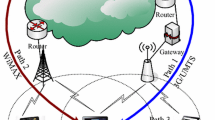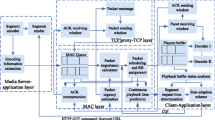Abstract
Multimedia streaming over heterogeneous wireless networks has attracted significant interest in recent years from both telecom network operators and end users. However, the heterogeneity of the wireless network makes it very difficult to synchronize real-time multimedia streaming to different types of end-user devices across different wireless networks. In addition, with different delay and packet loss across different networks, multimedia delivery over the heterogeneous wireless networks cannot provide good quality streaming video. This paper proposes CASHeW—a novel cluster-based design with an in-built feedback-based adaptive mechanism that results in a higher video perceived quality in two-hop heterogeneous wireless network environments. CASHeW employs a proxy-client-server mechanism between the base station (BS) and the end-user; and importantly uses a quality-oriented adaptive scheme for efficient multimedia delivery. Simulation-based tests indicate that the performance of CASHeW not only outperforms transport layer adaptive delivery protocols like the TCP-Friendly Rate Control Protocol (TFRCP) and Loss Delay Adaptation (LDA+), but also is better than that of medium access control (MAC) layer protocols such as the Receiver Based Auto Rate (RBAR) and Enhanced Distributed Channel Access (EDCA) in terms of average perceived quality, average bit rate and loss rate.
Similar content being viewed by others
References
Chen H. H., Guizani M. (2006) Next generation wireless systems and networks. Wiley, London
Toumpis S., Goldsmith A. J. (2003) Capacity regions for wireless ad hoc networks. IEEE Transactions on Wireless Communications 2(4): 736–748
Li B., Yin H. (2007) Peer-to-peer live video streaming on the internet: Issues, existing approaches and challenges. IEEE Communications Magazine 45(6): 94–99
Ananthapadmanabha, R., Manoj, B. S., & Murthy, C. S. R. (2001). Multihop cellular networks: The architecture and routing protocol. In Proceedings of IEEE International Symposium on Personal Indoor Mobile Radio Communications (PIMRC’01) (Vol. 2, pp. 78–82). San Diego, USA, 30 September–3 October.
Gupta P., Kumar P. R. (2000) The capacity of wireless networks. IEEE Transactions on Information Theory 46(2): 388–404
Grossglauser M., Tse D. N. C. (2002) Mobility increases the capacity of ad hoc wireless networks. IEEE/ACM Transactions on Networking 10(4): 477–486
Agarwal A., Kumar P. R. (2004) Capacity bounds for ad hoc and hybrid wireless networks. ACM Special Interest Group on Data Communications (SIGCOMM) 34(3): 71–81
Wu H., Qao C., De S., Tonguz O. (2001) Integrated cellular and ad hoc relaying systems. IEEE Journal on Selected Areas in Communication 19(10): 2105–2115
Glisic S. G. (2005) Advanced wireless communications—4G technologies. Wiley, London
Li B., Yin H. (2007) Peer-to-peer live video streaming on the internet: Issues, existing approaches and challenges. IEEE Communications Magazine 45(6): 94–99
Liu Y., Hoshyar R., Yang X., Tafazolli R. (2006) Integrated radio resource allocation for multihop cellular networks with fixed relay stations. IEEE Journal on Selected Areas in Communications 24(11): 2137–2146
Venkataraman H., Sinanovic S., Haas H. (2008) Cluster-based design for hierarchical two-Hop cellular networks. International Journal of Communication Networks and Systems (IJCNS) 1(4): 369–384
Muntean G. M., Cranley N. (2007) Resource efficient quality-oriented wireless broadcasting of adaptive multimedia content. IEEE Transactions on Broadcasting 53(1): 362–368
Padhye, J., Kurose, J., Towsley, D., & Koodli, R. (1999). A model based TCP friendly rate protocol. In Proceedings of the NOSSDAV.
Miyabayashi, M., Wakamiya, N., Murata, M., & Miyahara, H. (2001). MPEG-TFRCP: Video transfer with TCP-friendly rate control protocol. In Proceedings of the IEEE International Conference on Communications (ICC) (Vol. 1, pp. 137–141), June 2001.
Sisalem, D., & Wolisz, A. (2000). LDA+ TCP-friendly adaptation: A measurement and comparison study. In Proceedings of the NOSSDAV.
Rejaie, R., Handley, M., & Estrin, D. (1999). RAP: An end-to-end rate-based congestion control mechanism for real-time streams in the internet. In Proceedings of the INFOCOM (Vol. 3, pp.1337–1345). New York, USA. March 1999.
Holland, G., Vaidya, N., & Bahl, V. (2001). A rate-adaptive MAC protocol for multihop wireless networks. In ACM MOBICOM.
IEEE P802.11e/D13.0. (2004). Part11: Wireless Medium Access Control (MAC) and Physical Layer (PHY) specifications: Amendment 7: Medium Access Control (MAC) Quality of Service (QoS) Enhancements, September 2004.
McCanne, S., Jacobson, V., & Vetterli, M. (1996). Receiver-driven layered multicast. In Proceedings of the SIGCOMM. California, USA: Stanford, August 1996.
Padhye, J., Floyd, S., Handley, M., & Widmer, J. (2001). Equation-based congestion control for unicast applications. In ACM SIGCOMM 2000. Sweden: Stockholm, August/September 2001.
Muntean G. M., Perry P., Murphy L. (2004) A new adaptive multimedia streaming system for all-IP multi-service networks. IEEE Transactions on Broadcasting 50(1): 1–10
Jain, K., Padhye, J., Padmanabhan, V., & Qiu, L. (2003). Impact of interference on multihop wireless network performance. In Proceedings of the ACM MOBICOM (Vol. 2, pp. 66–80). September 2003.
Hassan, K. S., Haas, H., Yun, S., Lee, Y., & McLaughlin, S. (2007). Hybrid wireless communication system and communica-tion method using the same. Patent No: 200701121531. http://www.freepatentsonline.com/20070121531.html.
Venkataraman, H., Revanth, S., & Jaini, P. (2009). Optimum gateway position for cluster-based two-hop cellular networks. International Journal of Communications Networks and System Sciences (IJCNS) (Vol. 2, No. 4). July 2009.
Venkataraman, H., Nainwal, S., & Shrivastava, P. (2009). Optimum number of gateways in cluster-based two-hop cellular networks. AEU Journal of Electronics and Communications. Elsevier (Vol. 64, No. 4). April 2010.
Yu J. Y., Chang P. H. J. (2005) A survey of clustering schemes for mobile ad hoc networks. IEEE Communications Surveys, First Quarter 7(1): 32–48
Venkataraman, H., Krishnamurthy, A., Kalyampudi, P., McManis, J., & Muntean, G. M. (2009). Clustered architecture for adaptive multimedia streaming in WiMAX-based cellular networks. In Proceedings of World Congress on Engineering and Computer Science 2009, Vol. II WCECS 2009. San Francisco, USA, October 20–22.
Verscheure O., Frossard P., Hamdi M. (1999) User-oriented QoS analysis in MPEG-2 video delivery. Journal of Real-Time Imaging 5(5): 305–314
Subjective Video Quality Assessment Methods for Multimedia Applications, ITU-T Recommendation P.910, September 1999.
Network Simulator-2 [Online]. Available: http://www.isi.edu/nsnam/ns/.
http://www.four-faith.com/e_product_more.asp?ArticleID=281—last accessed on 12th March 2010.
Stuedi, P., & Alonso, G. (2007). Log-normal shadowing meets SINR: A numerical. study of Capacity in Wireless Networks. In proceedings of the 4th IEEE Conference on Sensor, Mesh and Ad-Hoc Communication and Networks (SECON’07). San Diego, California, USA. June 2007.
Matrawy, A., Lambadaris, I., & Huang, C. (2002). MPEG4 traffic modeling using the transform expand sample methodology. In Proceedings of 4th IEEE International Workshop on Networked Appliances (pp. 249–256), Gaithersburg, MD. January 2002.
Aizawa, K., Nakamura, Y., & Satoh, S. (2004). Advances in Multimedia Information Processing. In Proceedings of 5th Pacific Rim Conference on Multimedia, Tokyo, Japan, November 30–December 3, 2004, Part I. Lecture Notes in Computer Science 3331 Springer.
Dousse, O., Thiran, P., & Hasler, M. (2002). Connectivity in Ad hoc and Hybrid Networks. In Proceedings of IEEE International Conference on Computer Communications (INFOCOM) (Vol. 2, pp. 1079–1088). 23–27 June 2002.
Melamed B., Raychaudhuri D., Sengupta B., Zdepski J. (1994) TES-based video source modeling for performance evaluation of integrated networks. IEEE Transactions on communications 42(10): 2773–2777
Muntean G. M., Perry P., Murphy L. (2007) A comparison-based study of quality-oriented video on demand. IEEE Transactions on Broadcasting 53(1): 92–102
Lee S. B., Muntean G. M., Smeaton A. (2009) Performance-aware replication of distributed pre-recorded IPTV content. IEEE Transactions on Broadcasting 55(2): 516–526
Author information
Authors and Affiliations
Corresponding author
Rights and permissions
About this article
Cite this article
Venkataraman, H., Kalyampudi, P. & Muntean, GM. CASHeW: Cluster-based Adaptive Scheme for Multimedia Delivery in Heterogeneous Wireless Networks. Wireless Pers Commun 62, 517–536 (2012). https://doi.org/10.1007/s11277-010-0067-8
Published:
Issue Date:
DOI: https://doi.org/10.1007/s11277-010-0067-8




